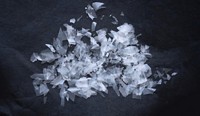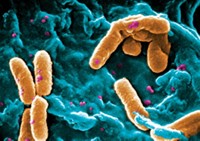Advertisement
Grab your lab coat. Let's get started
Welcome!
Welcome!
Create an account below to get 6 C&EN articles per month, receive newsletters and more - all free.
It seems this is your first time logging in online. Please enter the following information to continue.
As an ACS member you automatically get access to this site. All we need is few more details to create your reading experience.
Not you? Sign in with a different account.
Not you? Sign in with a different account.
ERROR 1
ERROR 1
ERROR 2
ERROR 2
ERROR 2
ERROR 2
ERROR 2
Password and Confirm password must match.
If you have an ACS member number, please enter it here so we can link this account to your membership. (optional)
ERROR 2
ACS values your privacy. By submitting your information, you are gaining access to C&EN and subscribing to our weekly newsletter. We use the information you provide to make your reading experience better, and we will never sell your data to third party members.
Environment
Shedding Nanoparticles
Materials Science: Chemists observe metal objects sloughing off ions to form nanoparticles
by Stephen K. Ritter
October 17, 2011

Silver and copper ions shedding from synthetic nanoparticles—and even from ordinary metal objects such as silverware and jewelry—combine to form new, smaller nanoparticles, a team of Oregon chemists has found. The discovery provides additional details about nanoparticle stability and behavior in the environment and implies that people have been exposed to significant background levels of metal nanoparticles for millennia.
Silver nanomaterials have been used for more than a century as a disinfectant and algaecide and in recent decades as an antimicrobial additive to clothing, cosmetics, pharmaceuticals, and consumer electronics. Both so-called nanosilver and naturally occurring silver particles are known to shed silver ions, which have been detected in rivers and wastewater treatment facilities and are thought to end up as innocuous silver sulfide (Environ. Sci. Technol., DOI: 10.1021/es103316q, 10.1021/es103946g).
Nanosilver is under scrutiny for its potential toxicity and persistence in the environment. The Environmental Protection Agency has struggled with how to test for and possibly regulate the materials because the risks, which may be dependent on particle size, are largely unknown (C&EN, Oct. 10, page 4). Coming up with a definitive answer has been slow because of the difficulty in detecting and monitoring nanoparticles in products and in the environment.
James E. Hutchison and Richard D. Glover of the University of Oregon, in conjunction with John M. Miller of Dune Sciences, a company Hutchison and Miller cofounded, have now developed a strategy to directly monitor weathering of synthetic nanoparticles and metal objects. The researchers tether particles to a silicon substrate, subject them to varying environmental conditions, and observe the results by electron microscopy and scanning probe microscopy techniques (ACS Nano, DOI: 10.1021/nn2031319). This method was made possible by specialized silicon-based grids developed in Hutchison’s lab and commercialized by Dune Sciences.
The researchers found that at room temperature and at relative humidity above 50%, “daughter” silver nanoparticles spontaneously form over days to weeks around “parent” nanoparticles. They believe air oxidizes the silver and resulting ions dissolve and diffuse in an adsorbed water layer on the substrate. New, smaller particles form by chemical and/or photoreduction of coalesced ions.
The team showed that macroscale silver objects such as wire, jewelry, and eating utensils placed in contact with surfaces form nanoparticles in the same fashion. Copper objects form nanoparticles as well, Hutchison says, suggesting that the phenomenon is general for readily oxidized metals.
The findings imply that nanoparticle formation is an intrinsic property of some metals and suggests that people have been exposed to significant background levels of incidental natural and manmade nanoparticles in the environment for millennia, Hutchison says. “For that reason, environmental health and safety concerns should not be defined or regulated based upon size,” he believes. “The findings also beg the question of what other incidental nanomaterials might exist in nature that we haven’t yet developed the tools to detect.”
“This exciting finding highlights the measurement challenges nanomaterials scientists face,” observes Robert I. MacCuspie, a research chemist at the National Institute of Standards & Technology, who characterizes nanoparticle surfaces and studies the behavior of nanoparticles in the environment. “Seemingly trivial changes in sample handling conditions and timing can alter nanoparticle size distribution measurement results,” MacCuspie says. The Oregon team’s paper helps emphasize that establishing baseline levels of nanosilver “is an urgent challenge” and that developing measurement protocols in parallel with reference materials is crucial for comparing results between laboratories.





Join the conversation
Contact the reporter
Submit a Letter to the Editor for publication
Engage with us on Twitter